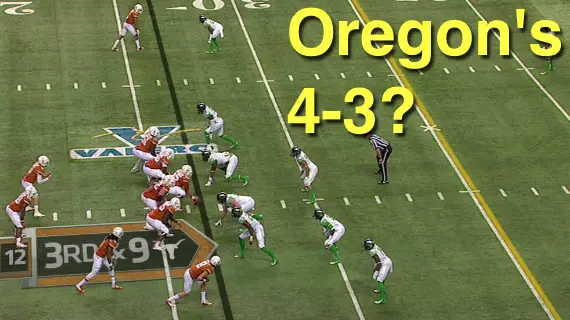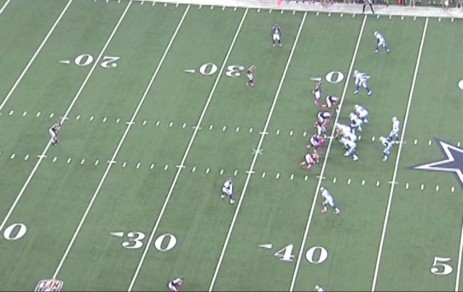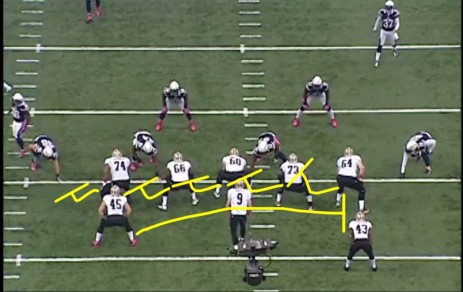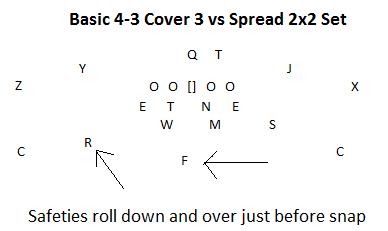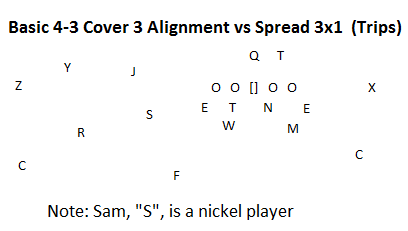(FishDuck Note: There have been rumblings about whether Oregon has better personnel to be running a 4-3 defense instead of a 3-4. This analysis by Coach Peterson helps us to learn the differences and to think of how Oregon operates defensively as you read it. Also keep in mind how so many conference opponents have gone to the Spread offense. Learning a little about the 4-3 can help us form opinions about the future of Oregon football. Enjoy!)
A lot of defenses today are going to the 3-4, which is the trendy thing to do. However, there is a lot of merit for running the 4-3 defense, especially against the Spread offense teams such as Oregon and so many other Spread variations in the Pac-12. Whether that’s the consistent pass rush, the simplified ways for the defense to “fit” against the run, or even from a defensive coverage perspective, the 4-3 defense does have a lot of advantages that make it worthwhile against the Spread offense, and gives us some strengths to ponder, considering the Ducks are changing Defensive Coordinators.

Lovie Smith
Lovie Smith, former head coach for the Chicago Bears, once told the media that he liked the 4-3 because the defensive line could focus on the one area that was most important in today’s defenses, and that is getting after the quarterback.
When he was asked about the element of surprise of the 3-4, he chuckled. He then elaborated, saying something like “Why would you want your best pass rusher to drop back 25 percent of the time or more?” His idea was simple, just like business – you let the best talent you have do the best they can in their roles, kind of like an assembly line. Once you start mixing things up, efficiency drops.
(FishDuck Note: Former Oregon Defensive Coordinator Bob Foster not only agreed with the prior sentence, but had studies and data confirming how the brain operates under mental and physical strain.)
Obviously, there have been many successful 3-4 defenses too, but I hope this analysis illustrates why many successful defensive coaches like the 4-3 defense. Now, when thinking about it against the Spread offense – and by Spread offense I mean using the shotgun and three or four receiver sets – it can be very effective. Many 3-4 teams will actually get into a four linemen set, even if the fourth lineman is a stand up linebacker who almost always rushes. This is because it simplifies the pass rush and what I call defensive “run fits.”
4-3 Defense Against the Spread: The Basics of Run Fits
What exactly are “run fits?”
Run fits represent how the defense will literally fit individual defenders against the offense’s running plays. For the defensive line and linebackers, this determines how fast they will run to their gap or to the ball carrier.
For the safeties and corners, they need to communicate to the linebackers if they are in a position to help them against the run. This is determined by the coverage and formation, as sometimes a safety might not need to be aligned over a slot receiver, yet other times he might be. If he’s not far removed from the formation, he maybe able to help the linebackers in their run fits, which will allow them to play outside runs differently.
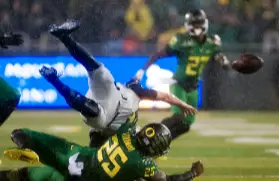
Now THAT is a force defender! (Bolo – No. 25)
By sitting in the 4-3 defense, run fits become simpler, especially against a team such as Oregon. Run fits usually equate to option responsibilities, as well.
For instance, the defender who is assigned the run fit of “force player” is responsible for “forcing” the run inside. For the option, he’s probably your “pitch” player, and sometimes your bubble player, depending on his alignment and the coverage.
If you’re in the 3-4 defense, those things still exist and are just as important. However, with players blitzing from different directions and different players dropping into coverage, it makes it harder to establish who is the force player. In addition to just knowing where to go, defenders need to know how to take on blocks and know where their teammates are. One bad angle or muffed responsibility can lead to a big play for the opposing offense, whereas with a 4-3, the assignments can be easier to recall, hence fewer mistakes.
For the 3-4 defense, constant communication must happen to ensure this works properly, and you’ll need to play to your weakest link. If you have one linebacker who is talented in every way, but plays blocks wrong, he’s a huge liability. So your defensive adjustments may need to be simplified, essentially meaning that some of that infamous 3-4 creativity may get lost. For the 4-3 defense, with four linemen, there are fewer variables to manage. Essentially, your best players can just run the defense called, rather than having to think. The defense, then, can play faster.
4-3 Defense Pass Rush Against the Spread

Fumble caused!
I think the next most important thing is the pass rush, because letting your best pass rushers get after the quarterback is essential. A lot of media and fans think the 4-3 defense can’t be creative like the 3-4 defense, with regards to the pass rush, and that’s simply not true. They think that a defense must have guys such as Julius Peppers, to get the sack.
Well, sorry to break it to them, but many of the same blitzes and stunts can be run from the 4-3 defense, with the four down linemen. In addition, there are plenty of ways the 4-3 defense can be creative – and again the Chicago Bears under Smith were a prime example. In fact, this creativity greatly amplified their pass rush, and should be strongly considered by 4-3 defensive coordinators.
(FishDuck note: Many times when the opposing team has third and long . . . we are doing our “Times Square” pass rush of milling around until the ball is snapped. This can be done from a 4-3, as well, and Oregon rarely blitzes before third down!)
Below is a diagram on how they rushed the passer. They use linebackers to fake as if they were blitzing, and by doing so it forces the interior linemen to honor their threat. A basic principle for many pass protections is protecting your inside gap first, thus if a linebacker walks up, you need to step that way.

Basic setup of the pass rush.

Notice how the center and guard step inside to prevent the blitz. This puts the right guard (No. 62), in a bad position to get “out-leveraged” by the defensive tackle.
While this one step may not seem like a lot, it can be huge in helping an undersized but quicker defensive lineman, to get a good first step and body position on a big offensive linemen, as you can see in the picture to the right.
What is most exciting about these kinds of stunts is that they only involve moving a player or two, and none of the linebackers has to blitz. So it’s very easy for defensive players to understand their responsibilities and they don’t need to learn a lot of new stuff, like how to align or the specific technique for handling blocks. It’s all very similar.
Popular 4-3 Coverages Against the Spread
One of the hardest things to do against the Spread is to defend an option running game which also features a four-receiver set. Four eligible receivers, which includes tight ends, forces the defense to respect “4 verticals,” which is a popular passing concept used by Oregon. The idea is simple from an offensive perspective, as the defense runs Cover 3 to stop the run, then the Spread offense runs four verticals and scores a touchdown.
Now, it’s by no means that simple – Nick Saban is the master of the Cover 3, and his teams do an excellent job at stopping the run and stopping the pass. ( The idea is match-ups, though.)
Not everyone has defenders like Saban does at Alabama. In the 4-3 defense, you don’t have to worry about telling a “outside linebacker” (who is really a glorified defensive end), that he has to blitz for the safety now because of a formation by the offense. There may be some switching of calls, but there is a lot less communication to worry about.
As for specific coverages, defenses will run all sorts of coverages against the Spread. As I’ve mentioned on FishDuck before, I prefer Cover 4 against spread sets, and I like Cover 3 against trips – three receivers on the same side – sets. However, you can adapt Cover 3 and Cover 2 successfully against Spread sets and the defense could always run man coverage or combo coverages as well.
Problems with the 4-3 Defense
The 4-3 will struggle a little bit when presented with five receivers and empty sets, as it’s a lot harder to disguise blitzes and stunts. However, slanting defensive tackles and looping ends can discourage quarterback draw plays.
However, many 4-3 teams will have a dime package that is designed to handle this problem where they use three linemen. Of course, if a team can legitimately use a running back as a receiver, this can make things much more difficult for a defense to plan for.
Additionally, if a defensive coordinator fails to disguise blitzes and stunts against the spread, and he can’t get a pass rush with the front four, the defense could be in trouble. It’s important to have a few blitzes – and to fake them, as well. It’s also important to use a wide variety of pass rush stunts.
Conclusions on the 4-3 defense against the Spread
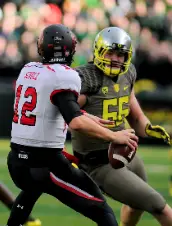
Oregon Defensive Lineman, Taylor Hart – No. 66
Overall, the 4-3 defense is a smart and effective option against the Spread. In all actuality, it might be a lot more like a 4-2 defense or a 4-1, depending on the receivers and the coverage, but that doesn’t change the scheme of the defense, as it could with the 3-4.
It’s a simple defense that’s been proven over time, because it’s easier to manage overall, and defensive coordinators can be just as effective, if not more, by running the 4-3. Might this be something that Oregon looks at, considering all the Spread teams in the conference?
If you really want to dig into the X’s and O’s of the 4-3, I have a free 40+ day, 13+ lesson 4-3 defense course that deals with the nitty gritty details of run fits and coverages. In addition, I do have some articles on the 3-4 defense as well as specific linebacker drills, if you want more information.
Coach Curtis Peterson
Indianapolis, Indiana
Curtis Peterson started coaching football in 2005 and he is the founder of Strong Football. He is currently a football coaching consultant for a few teams in the midwest. Coach Peterson welcomes your feedback, please follow him on Twitter at @CoachCP.

